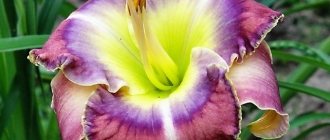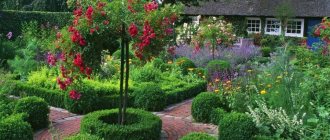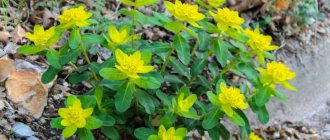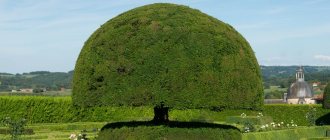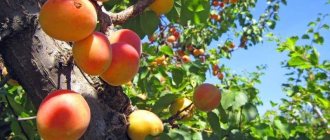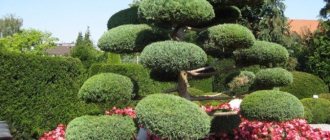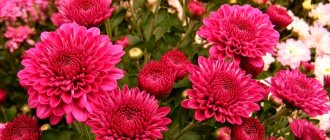Purpose of ornamental plants
The main purpose of ornamental plants is decoration. Such crops are divided into several types:
- Garden.
- Homemade.
- Aquarium.
Aquarium plants are a separate part here. They, in addition to performing their decorative functions, play an important role in the life of underwater inhabitants. Aquarium vegetation is divided into several types:
- Growing in the ground - limnophila, Indian fern, hemianthus dwarf, etc.
- Living in water are Aegagropyla, Moss monosolenium and Java moss.
- Living on the surface - Pistia, Riccia floating, Limnobium shooty, etc.
Duckweed is a small plant that lives on the surface of the water. It has small leaves with a convexity. The bulge is filled with air, which is why duckweed floats. Duckweed is used both as an ornamental plant and as an additive to the diet of fish. In addition, some fish use duckweed as cover for spawning. Duckweed is an unpretentious plant that takes root in almost any conditions. The main condition for its maintenance is a large amount of sunlight.
Java moss is a plant that lives in the water column. Its homeland is Southeast Asia. Moss looks like an interweaving of thin green threads. If left undisturbed, it can attach itself to objects and form attractive thickets. Fish use moss as a spawning site. The optimal temperature for moss is 23−28 degrees Celsius. At low temperatures it stops developing.
The Indian fern is one of the most popular aquarium inhabitants. In addition to decorative functions, it plays an important role in water purification.
When planting a fern, you should pay attention to the soil, it should be soft, sand is perfect. The optimal temperature ranges from 23 to 25 degrees. The aquarium should be in a well-lit place.
Trees for the garden
The fundamental part of the garden are trees and shrubs. Trees can be divided into deciduous and coniferous, and shrubs into climbing and flowering.
Coniferous trees decorate the garden throughout the year and are a salvation for the garden in the cold season. The main representatives of coniferous ornamental plants:
- Fir is an evergreen tree that belongs to the Pine family. A distinctive feature of fir is its cones that grow vertically, which other pine representatives do not have. The plant has about 50 varieties, which can reach a height of 30 cm to 80 m.
- Thuja is an evergreen, compact tree that exudes a pleasant spicy aroma. Thuja, like fir, has a large number of varieties. The average height of a tree ranges from 11 to 18 m, but there are also representatives up to 75 m high. All varieties of thuja are resistant to rotting and easily tolerate both winter cold and summer heat.
- Kupressociparis is a prominent representative of coniferous trees. The tree is fast growing, with a cone-shaped crown. By ten years of cultivation, the plant grows up to 8-10 m, and up to 2 m wide. The branches of the tree grow upward and have small scaly leaves.
Among deciduous trees, the most striking are:
- Canadian maple is a long-liver, living for 300-400 years. The leaf of this plant adorns the flag of Canada. The tree grows up to 40 m in height. Its crown is thick and wide, its diameter can reach 12 m. The tree reveals its beauty in the fall, coloring the leaves orange and bright red. The tree is frost-resistant, but suffers from gusty winds and hail. In the first years after planting, trees should be wrapped for the winter.
- Japanese crimson is a rather exotic tree that grows mainly in Japan and China. The tree can easily grow in central Russia, but in winter it needs to be looked after. The height of the crimson plant is 5−7 m, the crown has an ovoid shape. The leaves are especially beautiful in spring when they turn purple-pink. It is best to plant a tree in a lighted place, but not in direct sunlight - it can burn the plant.
- Chestnut is a tall tree belonging to the Beech family. It grows up to 35 meters in height. Its huge crown provides dense shade, and its beautiful flowers delight the eye every spring. In autumn, fruit pods grow on the tree. When they ripen, nuts will appear from there. Nuts are widely used in industry. Chestnut tolerates winter calmly, and can withstand heat in summer, but still, the optimal temperature for it is considered to be 20-27 degrees.
Which shrubs can be planted near the house and which cannot?
In addition to trees, you can plant the following beautiful shrubs near your house:
Lilac
Very often you can see lilac bushes near houses. And this is no coincidence. Lilacs look great near the house, filling the garden with a delicate aroma.
The shrub is strewn with lilac or white flowers, collected in paniculate inflorescences. Lilac blooms from May to June.
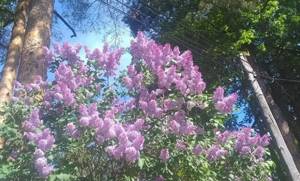
Lilac.
Park roses
Roses have always been the most beautiful bushes in the garden. Park roses bloom from late May to early June and are a shrub covered with flowers of a wide variety of shades.
Park roses look beautiful in group plantings. They are unpretentious and often have a pleasant aroma. They can be planted under the window.

Park rose.
Jasmine
Small carved jasmine leaves together with small white flowers create the impression of elegant lace.
Jasmine blooms from June to the end of summer and at the same time exudes a pleasant jasmine aroma. The bush grows up to three meters in height.
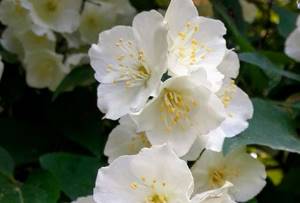
Jasmine.
Spirea
Spiraea can be a spring bloomer that pleases us with white flowers in May. It can be a summer bloomer, with pink flowers blooming in July.
The size of the shrub depends on the variety and can reach two and a half meters in height.
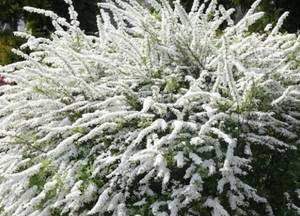
Spirea.
Heuchera
Heuchera is an elegant decoration for the garden. It has very beautiful carved foliage in bright red or blue.
This low-growing shrub effectively frames taller shrubs or flowers on tall stems.
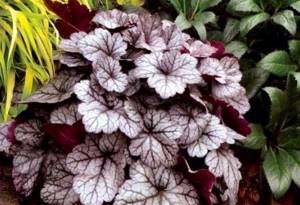
Heuchera.
Buddleya
Buddleia is a beautiful shrub up to three meters high with pink, lilac, white or yellow flowers collected in paniculate or spherical inflorescences. Their drooping appearance is especially attractive.
Buddleia blooms from May to late summer. Grows well in sunny, wind-protected areas.
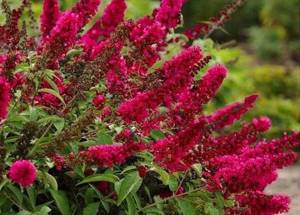
Buddleya.
Hydrangea
Hydrangea is called the queen of the garden. It blooms in August - September with beautiful small flowers collected in inflorescences. Flower color can be white, lilac or pink.
Hydrangea needs formative pruning. Then she becomes extraordinarily beautiful.
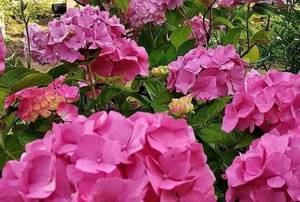
Hydrangea.
Weigela
Weigela blooms with pink or yellow flowers in the form of bells in May - July. The plant can be planted in sun or partial shade.
The weigela bush grows up to two meters in height.
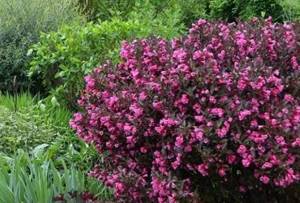
Weigel.
Barberry Thunberg
A stunningly beautiful shrub with bright leaves. The color can be very diverse: red, emerald green, yellow, purple-blue.
We choose a sunny or half-shaded area for it, protected from the wind. Can grow up to 3 meters in height.
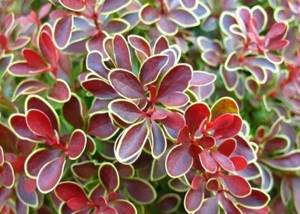
Barberry Thunberg.
Blooming
Flowering shrubs look very beautiful. To make flowers pleasing to the eye throughout the season, plant shrubs with different flowering periods.
Shrubs can be planted in groups of 3–5 specimens, and compositions can be made that include trees, shrubs and flowers. Bare trunks of shrubs decorate the site in winter, adding additional elements to the structure of the garden.
High
Shrubs can reach a height of three meters. For such tall plants, more space needs to be allocated accordingly. Tall shrubs such as lilac or jasmine look like trees. During the flowering period, such giants, strewn with bright flowers, look very beautiful.
Tall shrubs should be planted at a considerable distance from the wall of the house - 2.5-3 meters, so that the roots of the plant do not contribute to swelling of the foundation. It is also necessary to ensure that tall bushes do not obscure the windows of the house.
In Siberia
Residents of the northern regions can easily grow not only winter-hardy, but also heat-loving shrubs near their homes. However, you will have to cover them for the winter. If such troubles are not desirable for you, then limit planting near the house to only winter-hardy specimens.
What ornamental plants grow near a house in Siberia?
Winter-hardy shrubs include:
- lilac;
- spirea;
- hydrangea;
- buddleya.
Jasmine can be replaced with mock orange. It tolerates frost much better, and looks exactly the same as jasmine.
Behind the fence
More unpretentious species, such as lilac, barberry or mock orange, are usually planted behind the fence. These “simple” shrubs will serve as the beginning of the inspection, while real beauty will greet guests on the site itself in the form of park roses, spirea and hydrangea.
Shrub crops
Ornamental shrubs are a large group of perennial plants that have different shapes and proportions. Most ornamental shrubs are deciduous, but there are also coniferous specimens.
The most popular coniferous shrubs are:
- Juniper belongs to the Cypress family. The plant grows in height from 0.2 to 8 m. The shrub is very popular among gardeners and designers who use it to create rock gardens and rockeries. High varieties are used in the construction of hedges. Juniper leaves are scaly and have a pleasant aroma, which is especially noticeable after rain.
- Yew is a perennial ornamental shrub that has many varieties. Basically all varieties are small in size. The crown has a round, dense shape. The needles are quite tough. The fruits are presented in the form of red cone-berries.
- Cypress is an artificially bred shrub with decorative properties. The plant's growth is small, up to 1 m. The shrub has dense green needles. The cones are small with a small number of seeds. In autumn, the cypress tree acquires an unusual purple-violet color.
The most common deciduous shrubs are:
- Barberry Thunberg is a deciduous shrub. It usually grows up to 1 m in height, although it should reach 2.5 m. Barberry has bright shoots and ribbed needles that are red or red-orange in color. The berries are also red and ovoid in shape. The plant is practically not afraid of frost and various diseases.
- White dogwood is a beautiful shrub that gives the garden a special appeal. It has a large number of light inflorescences, and after flowering is completed it is covered with berries. The plant is quite unpretentious, so even a beginner can cope with its cultivation.
- The mountain ash plant is native to Asia. The plant got its name for its resemblance to rowan. It is used as a hedge and reaches a height of 2-3 m. The shoots of fieldfare are erect, 1-1.5 cm thick. The shrub is unpretentious and can be grown in various places in the garden, both in sunny and shaded areas.
There are other shrubs that are widely used in gardening: spirea, black elderberry, flowering weigela, and viburnum leaf.
Decorative garden trees and shrubs
All gardens have a certain number of shrubs, as well as tree varieties, which are divided into deciduous or coniferous. There are also flowering and climbing varieties. The choice is quite wide and you can purchase any of the options presented.
Types of trees
All trees that have decorative properties are divided into deciduous and coniferous. Conifers are evergreen and also have a permanent shape and are a good salvation for the garden during the off-season. The most famous representatives of coniferous plants are thuja, fir or cupressociparis.
Fir is a perennial tree with decorative features that has a permanent green color . It has a conical shape that is rounded at the top. It has a flat shape. The needles are dark green with a light stripe underneath. Fir produces purple cones.
Thuja is a perennial plant that remains green throughout the year. It has a pyramidal shape. The needles have an evergreen color. Can reach quite large size.
Cupressocyparis is an evergreen and perennial tree. The shape is columnar. The branches grow upward, with small scaly leaves. The tree grows very quickly and reaches up to 20 meters in height.
Pine and spruce can also be classified as a similar variety. They are also very beautiful and are decorative.
Deciduous ornamental trees:
- Canadian maple, which can reach quite large sizes. There is a dark cherry color of the leaves. The plant is frost-resistant and can withstand even severe sub-zero temperatures. It usually grows in partial shade, but can also live in light. When planting, it is best to choose any side except the darkened northern one.
- The small-leaved elm is a fairly large tree with an openwork border. The crown is quite dense.
- Japanese scarlet. The tree usually does not grow large and has an ovoid crown. The leaves are heart-shaped and have beautiful veins. A distinctive feature is the change in foliage color, which continues throughout the year. At first the color is pink, but in the end it acquires a blue-green tint. It has great frost resistance and also does not like direct sunlight. The plant must be watered thoroughly, because in the absence of moisture, all the leaves will fall off.
Chestnut, alder and birch are also deciduous trees that are used for decorative purposes.
Shrub variety
Shrubs represent a broader group of perennial plants that come in a variety of sizes and shapes. Usually the group is represented by deciduous plants, but there are also various coniferous representatives.
The most popular coniferous shrubs (evergreens):
- Juniper is a beautiful perennial shrub plant that has a large number of varieties. The needles are coniferous, and the leaves are scale-shaped. The needles are green, but turn brown in winter. Greenish berries grow on the bush. Juniper develops very slowly.
- Yew is a decorative variety of needles, which has a fairly wide selection of varieties. Almost all shrubs of this variety are small in stature. The crown is very thick, green in color and medium hard. The plant produces berries.
- Cypress. This plant was artificially bred. The bush grows very slowly and does not reach a height of more than one meter. The needles have a scaly shape. The needles have a green color, as well as yellow and blue tints.
All the bushes are very beautiful and can decorate any area.
Perennial deciduous shrubs:
- Barberry Thunberg is a very large shrub with purple colored leaves. The color changes depending on the season and can become coppery red. The branches are arched and droop as they develop. Usually lives in partial shade, but also tolerates light. It is frost-resistant.
- White turf. This is a small shrub. The shoots are red in color, and the leaves are light green with a white edge. In autumn the edging turns pink. Usually grows in shady areas. People often prune such a bush to give it a certain shape for the crown.
- Rowan-leaved fieldfare. The shrub is quite small in size, with elongated openwork leaves. The shoots vary in color and can be yellow, green and orange. Frost-resistant and resistant to various diseases, as well as insect pests. The bark has beneficial properties, and therefore traditional doctors often use them to treat diseases. It received its decorative advantages due to the structure and color of the leaves.
There are many more wonderful varieties. But these are the most popular among gardeners.
Climbing species
Very often in dachas or private plots you can see climbing plants that decorate some area of the territory. They are capable of not only beautifying an area, but also hiding various imperfections in fences, walls and gazebos.
All climbing plants have decorative properties, but some stand out especially:
- Clematis is a vine that can grow for several years. It has an original leaf shape. It can reach a height of up to 9 meters. Able to grow on illuminated surfaces and is easy to care for.
- Winged Thunbergia. The liana is annual and develops quite quickly. The leaves have hard pubescence, and the flowers are yellow with brown eyes. The plant is quite unpretentious and can grow in almost any conditions.
- Large-flowered Campsis. This vine is perennial. The leaves are green and very bright. The flowers are orange in color and bell-shaped. It is easy to care for, but it is best to cover it for the winter. It should be noted that this plant should never be over-watered. But it will not tolerate drought either. That is why watering must be carefully monitored.
When purchasing, be sure to learn about all the care details. Some species need to be monitored more closely than others.
Climbing species
Climbing plants are a special element in garden design. They not only improve the area, but can also eliminate various shortcomings of the fence, house walls, gazebos and other buildings.
All climbing plants play a decorative function, but the following are considered especially attractive:
- Clematis is a climbing plant with vine-like stems. There are also creeping and upright growing types. The roots can be fibrous or taproot. Depending on the species, the flowers have shades from white to bright purple. The sizes of flowers are also different, so in small-flowered ones they reach 3-5 cm, and in large-flowered ones they can grow up to 20 cm.
- Campsis is a deciduous plant of the Bignoniaceae family. It has beautiful tubular flowers of scarlet or orange that are a delight to look at all summer long. Kampsis shoots can grow up to 15 m in height over time. Campsis easily tolerates drought, but it should still be watered regularly. It is best to plant it in well-fertilized soil.
- Thunbergia alata is a type of ornamental planting and belongs to the Acanthus family. Thunbergia is native to Africa and the countries of southern Asia. The plant is perennial and heat-loving. In Russia it is grown as an annual. The flowers have a diameter of 4 cm and a long pedicel. They have different shades: from blue to red.
Also popular among gardeners are climbing species such as morning glory, hops, hydrangea, actinidia, etc.
Flowers for garden decoration
The most popular decoration for a site in the summer season are flowers. It is important to choose the right flower varieties for a harmonious combination with other plants. Flowers for the garden are divided into two groups: annuals and perennials.
Annual representatives of the flower family are:
- Crocus is an annual bulbous flower that belongs to the Iris family. Its stems and leaves are covered with translucent scales. Flowers are pollinated by insects and can be colored in both cool and warm shades. It is best to grow crocuses in a well-lit place where moisture will not linger for a long time.
- Brachycoma is a visitor from Australia and belongs to the Aster family. The plant is small, and most often the length of the stems does not exceed 12-30 cm. Despite its small size, brachycoma is spreading, making the crop look “fluffy”. The flowers of the plant also do not differ in size and do not exceed 3 cm in diameter. Brachycoma blooms until the end of September, which is good news.
- Lavatera is an excellent option for arranging flower beds and flower beds. The bushy plant blooms almost the entire summer season. Lavatera flowers are cone-shaped and cover the area with a carpet of different colors.
Popular perennials that are popular with gardeners are:
- Daisy is another representative of the Astrov family. The plant is native to Southern and Central Europe. The height of the bush reaches 18−30 cm. Flowers can be reed or tubular in shape. In gardening, the plant is used for group plantings and as a greenhouse decoration.
- Phloxes are beautiful and bright flowers of the Cyanaceae family. The plant has high decorative properties, as well as unpretentiousness, which allows flowers to grow on almost any soil, with any lighting. Phlox has many types, which differ from each other in the color and height of the bush.
- Hydrangea is part of a family that has about 80 species of flowers. It blooms from spring to late autumn. Its inflorescences are located at the ends of its stems and have a spherical shape. Most often the plant is white, but there are specimens with other shades.
Herbs and perennial flowers
It is profitable to plant perennial herbs and flowers for the garden - with the right choice of material and location, outdoor ornamental plants will delight the eye with a variety of colors and shapes for many years. Every year you can change the palette of colors - plant annual flowers between perennials.
Useful information: Growing daffodils
Arabis or rezuha (Arabis)
Arabis are early-blooming honey-bearing groundcovers, the height of which, together with the peduncle, does not exceed 30 cm. The stem is climbing, rooting. The entire pubescent leaf is silvery-white in color and has denticles along the edge. Sometimes the basal leaves form a beautiful rosette. A dense umbrella-shaped inflorescence is formed from small pink, white, and purple flowers. Flowering is early (April) and long lasting – about two months.
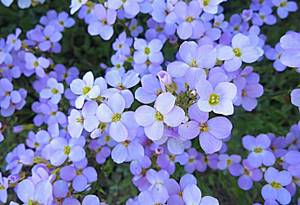
Common garden varieties:
- Flore Pleno – height 30-35 cm, large, double, pink flower;
- Pink Frost – petals of delicate shades of pink;
- Rote Sensation – elongated leaf, pink petals:
- Shneehaube – double flower, white.
Astilbe
Representatives of the genus are rhizomatous herbaceous perennials, the above-ground part of which dies in the fall. The stems vary in height - 10-200 cm. The leaves of most species are beautifully dissected, with a finely toothed edge, the color is dark shades of green or reddish-green. The apical lush rhombic or pyramidal inflorescence consists of small flowers of various colors. If you select varieties with different flowering periods, then astilbe will decorate the area all summer.
Related article:
Popular types and varieties of juniper
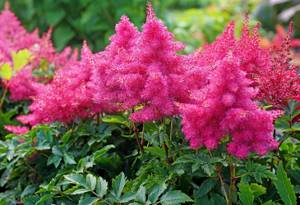
Interesting varieties:
- A. Chinese (A. chinensis) - unpretentious, grows quickly, stems up to 1 m in height, glossy leaves, covered with red hairs along the edges, a beautiful dense inflorescence formed by lilac, white, pink flowers;
- Thunberg (A. thunbergii) - a dense, medium-high bush (up to 80 cm), the surface of the dark green carved leaf is covered with brownish hairs, the wide pyramidal large inflorescence consists of bright white small flowers, goes well with deciduous crops and ornamental grasses;
- Amethyst, Erica, Rubin, Serenade are beautiful varieties of Arends astilbe.
Periwinkle (Vinca)
A herbaceous creeping perennial will help out if there are shady areas where other crops do not grow well. It grows well both in wet lands and in those that quickly lose moisture. The stems are covered with small shiny leaves of dark shades of green, they grow quickly, occupying the provided area. The flowers are single, small, lilac, purple, blue, light blue, and pink. Blooms from spring until frost.
Related article:
Licorice for your garden: types, description and properties
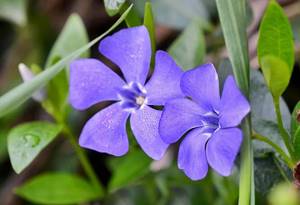
Types of periwinkle: large, small, pubescent, pink, herbaceous.
Spreading boron (Milium effusum)
A spectacular, beautiful herbaceous plant that will enliven and decorate a shady flower garden or a damp area of the garden. In mid-latitudes it winters without problems. Most decorative in spring and the first month of summer. A bunch of smooth flat yellow leaves against the background of familiar greenery looks like a lace pattern.
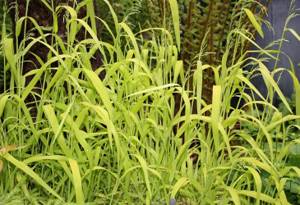
On a tall (40-50 cm) stem, peduncles form, drooping under the weight of yellowish-green flowers that look like millet seeds. Suspends development in extreme heat. Creates a contrast with blue hostas, brightly flowering annuals.
Dicentra magnificent (Lamprocapnos spectabilis)
In common people the flower is called “broken heart”. It blooms profusely and for a long time in partial shade, fades in the sun and quickly fades. The perennial is beautiful not only during flowering - the petioled leaves divided into lobes look original against the background of crops with a different shade of green.
Related article:
How to transfer lilies of the valley from the forest to the site
Flowers with pink or white outer petals and reddish, white inner petals look like dangling hearts. The racemose inflorescence bends in the shape of an arc under their weight, which gives the bush a delicate outline.
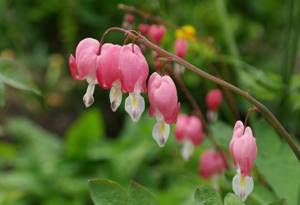
Original varieties:
- Alba and Snowdrift - snowy white petals;
- Gold Heart - golden yellow leaf.
Italian bristlecone or mogar (Setaria italica)
Drought-resistant herbaceous annual that prefers bright sunny areas. The height varies - from 10 to 100 cm. Nowadays it is popular as an original ornamental plant, diluting the elegant beauty of garden crops with its simplicity.
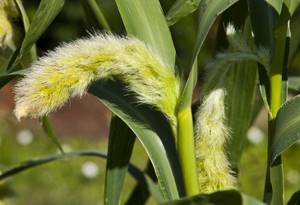
Growing in the form of dense bunches (height from 50 to 150 cm), it forms a closed herbage. The leaf is long, rough, the inflorescence looks like a spike-shaped shaggy panicle. The flowering period lasts from July to August. Planted as a tapeworm, as a hedge, for cutting, for winter bouquets, for decorating paths, lawns, and diluting flower beds with greenery.
Room dwellers
All indoor representatives have different types of decorative properties: upright, shrubby, hanging and tree-like plants.
One of the most popular upright growing flowers is anthurium. The flower loves warmth, as it comes from warm countries. The peculiarity of the plant is its unusual leaves, flowers and colors.
The unpretentious balsam can be classified as a shrub species. It blooms long and profusely. Also has a variety of colors. The plant is moisture-loving. Despite its small size, it can have long leaves.
Hibiscus is a tree-like houseplant. It blooms constantly and has thin and soft flowers. Its distinctive feature is its flowers, which bloom for only one day and then die.
Ampelous representatives include lobelia, which has decorative flowing leaves. The flower is considered unpretentious and does not require special care.
Of course, this is not the entire list of ornamental crops and plants, but only a small, most popular part of them.

